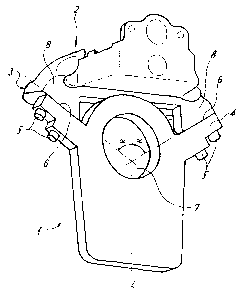Some of the information on this Web page has been provided by external sources. The Government of Canada is not responsible for the accuracy, reliability or currency of the information supplied by external sources. Users wishing to rely upon this information should consult directly with the source of the information. Content provided by external sources is not subject to official languages, privacy and accessibility requirements.
Any discrepancies in the text and image of the Claims and Abstract are due to differing posting times. Text of the Claims and Abstract are posted:
| (12) Patent Application: | (11) CA 2568699 |
|---|---|
| (54) English Title: | BRAKE MECHANISM |
| (54) French Title: | SYSTEME DE FREINAGE |
| Status: | Deemed Abandoned and Beyond the Period of Reinstatement - Pending Response to Notice of Disregarded Communication |
| (51) International Patent Classification (IPC): |
|
|---|---|
| (72) Inventors : |
|
| (73) Owners : |
|
| (71) Applicants : |
|
| (74) Agent: | SMART & BIGGAR LP |
| (74) Associate agent: | |
| (45) Issued: | |
| (86) PCT Filing Date: | 2005-03-24 |
| (87) Open to Public Inspection: | 2005-10-13 |
| Availability of licence: | N/A |
| Dedicated to the Public: | N/A |
| (25) Language of filing: | English |
| Patent Cooperation Treaty (PCT): | Yes |
|---|---|
| (86) PCT Filing Number: | PCT/EP2005/003155 |
| (87) International Publication Number: | WO 2005095815 |
| (85) National Entry: | 2006-11-29 |
| (30) Application Priority Data: | ||||||
|---|---|---|---|---|---|---|
|
Disclosed is a brake mechanism comprising a connecting element (1) that is
fixed to a wheel axle of a motor vehicle or is embodied monolithically
therewith, and a fastening flange (3) of a disk brake caliper (2), said
fastening flange (3) being fixed to the connecting element (1). The inventive
brake mechanism is configures in such a way that the fastening flange (3) is
retained in a positive manner on the connecting element (1) in the
circumferential direction of the wheel axle.
La présente invention concerne un système de freinage comprenant un corps de raccord (1) qui est fixé sur un essieu de roues d'un véhicule automobile ou forme une seule pièce avec celui-ci, et une bride de fixation (3) d'un étrier de frein (2) d'un frein à disque, la bride de fixation (3) étant fixée au corps de raccord (1). Le système de freinage est conçu de sorte que la bride de fixation (3) est maintenue dans la direction périphérique de l'essieu de roues, par liaison de forme contre le corps de raccord (1).
Note: Claims are shown in the official language in which they were submitted.
Note: Descriptions are shown in the official language in which they were submitted.

2024-08-01:As part of the Next Generation Patents (NGP) transition, the Canadian Patents Database (CPD) now contains a more detailed Event History, which replicates the Event Log of our new back-office solution.
Please note that "Inactive:" events refers to events no longer in use in our new back-office solution.
For a clearer understanding of the status of the application/patent presented on this page, the site Disclaimer , as well as the definitions for Patent , Event History , Maintenance Fee and Payment History should be consulted.
| Description | Date |
|---|---|
| Application Not Reinstated by Deadline | 2011-03-24 |
| Time Limit for Reversal Expired | 2011-03-24 |
| Inactive: Abandon-RFE+Late fee unpaid-Correspondence sent | 2010-03-24 |
| Deemed Abandoned - Failure to Respond to Maintenance Fee Notice | 2010-03-24 |
| Letter Sent | 2007-08-21 |
| Letter Sent | 2007-08-21 |
| Inactive: Single transfer | 2007-06-05 |
| Inactive: Courtesy letter - Evidence | 2007-02-06 |
| Inactive: Cover page published | 2007-02-02 |
| Inactive: Notice - National entry - No RFE | 2007-01-29 |
| Application Received - PCT | 2006-12-28 |
| National Entry Requirements Determined Compliant | 2006-11-29 |
| Application Published (Open to Public Inspection) | 2005-10-13 |
| Abandonment Date | Reason | Reinstatement Date |
|---|---|---|
| 2010-03-24 |
The last payment was received on 2009-03-11
Note : If the full payment has not been received on or before the date indicated, a further fee may be required which may be one of the following
Please refer to the CIPO Patent Fees web page to see all current fee amounts.
| Fee Type | Anniversary Year | Due Date | Paid Date |
|---|---|---|---|
| Reinstatement (national entry) | 2006-11-29 | ||
| Basic national fee - standard | 2006-11-29 | ||
| MF (application, 2nd anniv.) - standard | 02 | 2007-03-26 | 2007-02-12 |
| Registration of a document | 2007-06-05 | ||
| MF (application, 3rd anniv.) - standard | 03 | 2008-03-25 | 2008-02-07 |
| MF (application, 4th anniv.) - standard | 04 | 2009-03-24 | 2009-03-11 |
Note: Records showing the ownership history in alphabetical order.
| Current Owners on Record |
|---|
| KNORR-BREMSE SYSTEME FUR NUTZFAHRZEUGE GMBH |
| DAIMLERCHRYSLER AG |
| Past Owners on Record |
|---|
| JOHANN BAUMGARTNER |
| STEFAN SAGERER |
| UWE MAUZ |